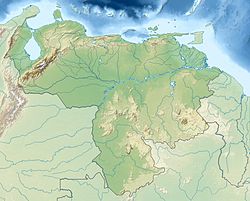| UNESCO World Heritage Site | |
|---|---|
 An aerial view of the hall in 2011 | |
| Location | University City of Caracas, Caracas, Venezuela |
| Criteria | Cultural: (i), (iv) |
| Reference | 986 |
| Inscription | 2000 (24th Session) |
| Coordinates | 10°29′27″N 66°53′26″W / 10.49083°N 66.89056°W |
The Aula Magna is an auditorium at the Central University of Venezuela. It is located within the University City of Caracas, next to the University's main library building. The hall was designed by the Venezuelan architect Carlos Raúl Villanueva in the 1940s and built by the Danish company Christiani & Nielsen from 1952–53. It was declared a UNESCO World Heritage Site in November 2000 for being artistically and architecturally significant. The most notable feature of the hall is its acoustic 'clouds', which serve both aesthetic and practical functions. They are an element of the hall's design which contributed to the science of interior space acoustics, though the building exterior is also architecturally significant.
The Aula Magna has been named the "most important auditorium" at the university.[1] This is in part because of practicality: it is the largest capacity auditorium, being able to hold approximately 2,700 people with removable seats. However, it is also significant because of the academic, artistic, and political events which have taken place within it. Some of these events have been of great importance for the country and some have been part of historical movements. In present-day Caracas, the hall has been a site of political controversy, as well as suffering from a lack of maintenance funds.
The current director of the hall is Trina Medina, with the assistant director Rosario Silva Prieto.[2]


